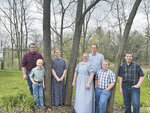

HILLSBORO, Wis. — Kurtis and Valerie Oberholtzer value good, functional cows that make a lot of milk. Their dedication to this type of cow has been recognized by Holstein Association USA Inc. as they were one of six winners of the Herd of Excellence award this year.
“It came as a surprise,” Kurtis Oberholtzer said. “It’s not like we’ve been working hard for the last 17 years hoping to win this award.”
Kurtis and Valerie, with their five children, milk 50 cows near Hillsboro. They have a rolling herd average of 35,363 pounds of milk, 1,477 pounds of butterfat and 1,131 pounds of protein. Their average classification score is 85.8.
The couple has been farming together for 17 years. They have consistently won milk quality awards and the Progressive Breeders’ Registry award. But this is the first time they have won the Herd of Excellence award.
To be eligible for the award, the herd must have classified within the last year and have an age-adjusted classification score of 83 points or higher. As well, at least 70% of the herd must be homebred and enrolled in the association’s TriStar program. Production criteria are scaled for different-sized farms in three divisions: 10-99 cows, 100-499 cows and 500-plus cows. The Oberholtzers’ division required 25% of the herd to be above breed average mature equivalent for milk, fat and protein.
“This is like the award of awards,” Valerie said. “It’s rewarding for all the time we put into it.”
Valerie grew up with registered cattle and learned how to mate cows from her dad, Dean Good. When making breeding decisions, Valerie looks for a lot of milk, good components and sound feet and legs.
The couple ships milk to Grassland Dairy Products where all their milk is made into butter. Because the creamery pays a high premium for butterfat, Kurtis and Valerie have focused on breeding for components. This has paid off in the milk check, Valerie said. They normally receive a $3 per hundredweight premium on butterfat alone, and another $1 to $2 for protein and somatic cell count premiums, which helps to offset the cost of trucking.
“It’s what keeps you rolling,” Valerie said. “We’re paying for our farm by milking cows. You can have a fancy cow in the barn but if she won’t make a good milk record, we can’t pay the bills.”
Valerie pays attention to the genomic Total Performance Index, but also likes to see a family history of production instead of relying on one good genomic score. If a bull has a good genomic score but lacks a family history of high production and components, Valerie remains skeptical. In her dad’s herd and the one she owns with Kurtis, she has seen a good heifer can come out of a cow family that she does not want to breed from.
“For all those years my dad taught me, we were following good cow families and tapping into other people’s good cow families and that is what we were breeding on,” Valerie said. “I will not move away from that, ever, because good cows make more good cows.”
Kurtis and his sons do all the feeding and crops on the dairy. They feed a total mixed ration of corn silage, haylage and high-moisture corn. They also use a protein mix and a microbial supplement. Kurtis said consistency is important.
“We try not to make big switches,” Kurtis said. “We always feed corn silage and haylage and high-moisture corn. So, if we’re short on haylage we ration it to make sure we always have that.”
Kurtis also pulls feed samples at least every four weeks. Feed is chopped and stored in silos and bags.
The couple started the herd with a few cows Valerie brought from her dad’s farm, some purchased cows from her dad’s friends and a group of 12 cows from Lancaster. Three of the cows owned with her dad carried his prefix, as do their descendants. Thus, 94% of the current herd is homebred and carries the Kal-side prefix.
Besides the Herd of Excellence award, the couple has recently received recognition for three cows that won state records last year. One of them, Bonnie, was the state’s highest protein-producing cow and the others were among the top 10 fat-producers.
They also have a heifer that has scored high enough to gain attention. They have started in vitro fertilization to breed a bull for ABS Global or SEMEX.
“We wanted to raise our children on a farm, just as our parents and grandparents did,” Valerie said. “We would like to give God the credit for giving us the blessing of farming with our children here. This has been a great blessing from the Lord.”
Comments
No comments on this item Please log in to comment by clicking here